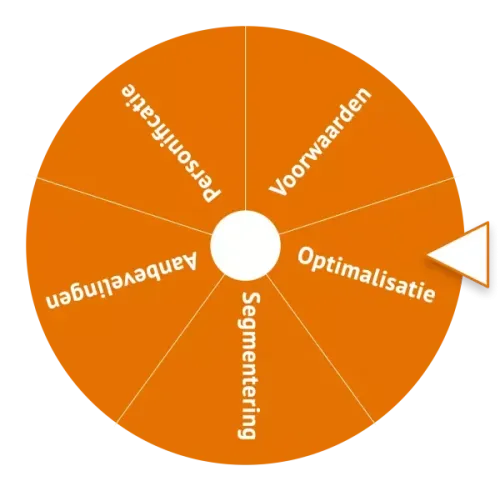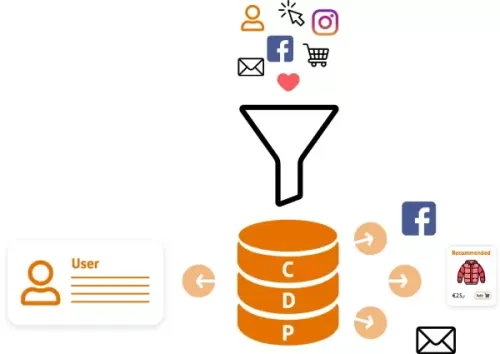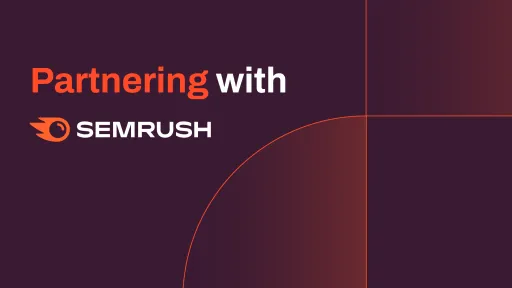Innovations in personalization, data, and smart algorithms are rapidly advancing at the moment. However, a large portion of websites and webshops still offer a static experience to the consumer. Personal interests and demographic data are rarely used to improve the customer experience on a digital platform.
When you compare that to the use of digital advertising channels like Google Ads, TikTok, or Meta, it is certainly interesting. These touchpoints are very suitable for reaching specific target audiences with specific interests.
The connection between the advertising channels and the website or webshop does not always go smoothly. You go from a personalized ad to a general experience.
It's a real shame because 91% of consumers say they are more likely to buy from brands that offer them a personalized experience. Additionally, 48% of consumers say they have left a company's website simply because the site was poorly put together.
However, this doesn't have to be the case at all. It is possible to personalize your website (and virtually all facets of the customer journey) based on various factors, allowing these segments to seamlessly flow through the funnel.
What is personalization?
Unfortunately, defining the term 'personalization' is not easy. There are different ways you can categorize this definition:
- Conditions – like an IF, THEN statement. If the user is not logged in, then we show the “Sign Up” button. If the user is logged in, then we replace the “Sign Up” button with the “My Account” button.
- Optimization – personalization is simply a more targeted lens of optimization.
- Segmentation – personalization is simply segmentation.
- Recommendations – personalization is about relevance, so they are simply recommendations.
- Personification – to be considered personalization, one must use data that is personal.

The topic of personalization is so conceptual and broad that an all-encompassing description, ironically enough, would become so generic that it no longer holds water. The benefits of personalization are so broad that they are unique to each business goal.
We describe personalization as a collective term for all activities that ensure an experience is tailored to the visitor. This makes it possible to offer a personal customer journey across all online touchpoints where information, products, and/or services are delivered on a tailored basis. Means such as segmentation, recommendations, or targeting support achieving that goal.
Some examples of personalization are:
- Sending a personal birthday or anniversary greeting to a customer, with a special offer or discount to celebrate the occasion;
- Netflix recommending movies based on the films you have previously watched;
- Spotify creating personal playlists of songs they expect you will like based on your listening history.
What is the added value of personalization?
Consumers expect companies to offer them a personalized experience that goes beyond the usual, straightforward marketing segmentation. Through personalization, consumers receive interactions that are better tailored to their needs and consistent throughout the entire customer journey. It helps them find better offers/prices, saves time, helps them find new information, simplifies the buying process, and so on.
As mentioned at the beginning of this article, research by Accenture Interactive shows that 91% of consumers are more likely to buy from brands that offer them a personalized experience. Think of brands that recognize them, remember them, and provide relevant offers and recommendations. Additionally, 48% said they have left a company's website and made a purchase on another site or in-store, simply because the site was poorly put together.1
This also immediately highlights a benefit for companies: personalization increases the conversion rate of your website. Additionally, it can increase engagement, improve lead generation, enhance customer/user retention, and boost retention. On a large scale, this can result in 50% lower acquisition costs, 5-10% higher revenue, or 10-30% more efficient marketing spend.2
Are you intimidated by personalization or find the topic daunting due to the amount of work, maintenance, required expertise, etc.? More and more personalization tools are entering the market, providing a suitable solution for every situation. In the next section, I will delve deeper into the different types of personalization tools with examples.
Different types of personalization tools
There are many different types of personalization tools available. Which tool is suitable for your organization depends on the goal and digital maturity of your company.
Five categories of personalization tools are:
- Client-side: Client-side personalization refers to the use of client-side software or technologies to enable personalized experiences. These tools collect data about the customer, such as cookies or tracking pixels, and use that data to tailor the content or experience to the customer. Client-side personalization can be used to customize the appearance and functionality of a website or app to the preferences and needs of individual users. This can include displaying personalized recommendations, adjusting the layout of the site based on the user's device or screen size, or remembering the user's login credentials so they don't have to be re-entered on each visit.
A major advantage of client-side personalization is that it can be relatively easy and inexpensive to implement, without complex infrastructure or specialized technical expertise. However, it does depend on the user's device and browser to function properly, and it can be limited by the amount of data available about the user. A client-side personalization tool is often also dependent on client-side cookies, which can impact the effectiveness of the tool.
- (Cloud) Recommendations: (Cloud) recommendations are algorithms and technologies used to recommend products or content to users based on their past behavior or preferences. These recommendations are usually generated in real-time using data collected and analyzed in the cloud. The idea behind recommendations is to provide users with personalized, relevant recommendations that interest them, in the hope that they will be more likely to engage with the recommended content or make a purchase.
Recommendation engines can be integrated into various types of platforms, such as e-commerce websites, streaming services, and news websites. They can be based on different types of data, including a user's browsing and search history and previous purchases. Both Google and Amazon offer services where these recommendations can be integrated within existing platforms via API calls (application programming interface).

- DMP: Data Management Platforms (DMPs) are tools that allow companies to manage and organize their customer data from various sources. A DMP collects data from different sources, such as websites, mobile apps, and social media, and combines it into a single platform. This gives companies a more comprehensive view of their customers and their behavior. DMPs work almost exclusively with anonymous entities such as cookies, devices, and IP addresses, rather than personally identifiable information.
A major advantage of DMPs is that they can provide a central location for storing and organizing customer data, making it easier for companies to use that data to make informed decisions about marketing and advertising efforts. DMPs can be used to segment customers based on various criteria, such as their interests, demographics, or behavior. They can also be used to improve the targeting and efficiency of advertising campaigns by showing ads to the right users at the right time.
- CDP: Customer Data Platforms (CDPs) are similar to DMPs, but they typically focus specifically on customer data and may include additional features and capabilities for managing and organizing that data. With a CDP, companies can segment their audience, set up targeted marketing campaigns, and measure the effectiveness of those campaigns. This can help companies personalize their marketing efforts and improve the overall customer experience. CDPs work with both anonymous and known personal data and store personally identifiable information, such as names, addresses, email addresses, and phone numbers.
CDPs are often used for personalized marketing activities, such as personalized email campaigns, targeted ads, and personalized recommendations. CDPs can be particularly useful for companies that want to offer a highly personalized customer experience, as they allow for deeper insights into individual customers and their needs and preferences.

- Reverse ETL: Reverse ETL, or Extract, Transform, Load, is a personalization tool that allows companies to load customer data into operational tools, such as Meta Ads, Google Ads, etc., via a data warehouse. From these operational tools, the customer journey can be personalized. This process is the reverse of the traditional ETL process, which is used to load data from various sources into a data warehouse.
A major advantage of Reverse ETL in conjunction with a data warehouse is that it allows companies to extract and analyze customer data from various sources, providing a more complete picture of their customers and their behavior (single source of truth). With this data, companies can set up targeted marketing campaigns and measure the effectiveness of those campaigns. It can also help companies improve the overall customer experience by providing deeper insights into individual customers and their needs and preferences. Additionally, Reverse ETL can be used to comply with data privacy regulations, such as GDPR, by allowing companies to extract and delete personal data from third-party platforms.
Examples of personalization tools
Squeezely, Relay42, and Hightouch are all personalization tools that help companies create more personalized experiences for their customers. While all three tools have similar capabilities, there are some key differences that make them better suited for different types of businesses and applications.
Squeezely

Squeezely is a CDP that provides customers with personalized content and experiences. It allows companies to create and send personalized emails, web pages, ads, WhatsApp messages, push notifications, and even physical cards based on customer data and behavior. This makes it truly an activation platform.
Squeezely has its own personalization engine, which includes a wide range of personalization options, such as website personalization, (real-time) product recommendations, and a real-time persuasion tool. Additionally, it is possible to A/B test within the tool, and Squeezely has a Journey Builder, which allows you to map out individual customer journeys and automate specific triggers.
What makes Squeezely particularly unique compared to other personalization tools is its ease of use. While some personalization tools require significant data science skills to even use the tool, Squeezely aims to excel through its easy interface. This makes it very simple for a company to start with their personalization.
But this certainly doesn't mean that Squeezely is just an entry-level personalization tool. As a developer, all elements can be further customized using HTML, CSS, etc. Squeezely is just not specifically an enterprise software tool. Enterprise software tools are specifically designed for large companies and organizations with a large number of users and complex needs. So if your company does have this need, perhaps one of the following tools is better suited.
Squeezely is available from €849 per month.
Relay42

One of these enterprise-grade personalization tools is Relay42. This data-driven CDP combines CDP and DMP capabilities in one platform, which makes sense when you consider that the program started as a first-party data DMP. It uses customer data to create personalized content and experiences across multiple channels, including email, web, social media, and digital advertising, to create personalized customer journeys.
What does it mean that Relay42 is an enterprise-grade tool, you might ask? This means that the program is not only capable of handling but is even designed for massive infrastructures, global presence, and large marketing teams. Additionally, Relay42 is also certified by the Customer Data Platform Institute. This means that the program meets a set of characteristics that a product needs to perform the functions most users expect from a CDP.
The platform includes its own tag management system, which works very closely with the personalization system, meaning you really have to set it up. While setting this up will take some extra work, the beauty of this system is that it is not dependent on (3rd party) cookies, which is a nice prospect in this day and age.
Relay42 also includes features such as automation, real-time targeting, and Machine Learning-driven prediction models, making it easy to deliver personalized experiences at scale. It is also the only platform built for AI-driven customer journeys with real-time connectivity to all systems and touchpoints.
The price of the tool is only available upon request, but there is the option to request a demo.
Hightouch

Unlike Squeezely and Relay42, Hightouch is not a CDP but a Reverse ETL. With this, you synchronize your data directly from your data warehouse to 125+ destinations, such as Google Advertising Manager, Adobe Target, Facebook, and more. According to Hightouch, this is a purer way of measuring because you create your customer profiles based on all your data stored in your data warehouse, instead of the portion stored in a CDP. This way, you have one source of truth and prevent different teams from looking at different data sources. It is important to note with this tool that you do need a separate data warehouse for it.
Hightouch synchronizes data from any data warehouse with the SaaS (Software as a Service) tools your company runs on. Using SQL or their audience builder, you can synchronize live data with your sales, marketing, and customer success tools without technical efforts. But it is more than just a Reverse ETL tool. According to themselves, Hightouch is a 'Data Activation Platform,' which means they have shifted their focus from understanding data to taking action based on that data.
You use Hightouch's platform to build your segments. This can be done using a 'no-code audience builder' or for more complex segments, it can be done using SQL code. Hightouch's functionalities don't stop at building segments; you can also split these segments to run multi-channel A/B tests and create priority lists to prevent people in your funnel moving from ToFu (Top of Funnel) to MoFu (Middle of Funnel) from seeing the same marketing expressions.
The latest functionality Hightouch has recently announced is an API that allows you to directly link the data from your data warehouse to your website. This allows you to personalize your website per user based on all the data you have stored in your data warehouse.
Hightouch is free to use, allowing connections to be made with all free destinations (such as Google Sheets, Slack, and Teams) and 1 extra connection (excluding premium destinations).
Personalization: A key to success in the digital age
The goal of personalization is to tailor the online experience of your (potential) customer to their specific needs and interests, which can lead to a better customer experience and therefore more valuable conversions. There are various tools and techniques available to achieve this, such as using cookies, collecting user data, and using recommendation algorithms. It is mainly important to consider which personalization tool best suits your company's objectives and your target audience's needs.
Do you represent a small to medium-sized organization, don't have super high traffic on your website, and/or haven't installed a data warehouse yet, but want to quickly make strides with personalization? Then Squeezely is the tool for your organization.
Do you represent a very large organization and want to be less dependent on 3rd party cookies for your personalization actions? Then Relay42 might be exactly what you're looking for.
Do you have a fully set up data warehouse with a lot of data that you want to use for your marketing/personalization actions? Then you'll find your fit with Hightouch.
2. https://kameleoon.com/sites/default/files/kam/wp-personalization-2020-EN.pdf




